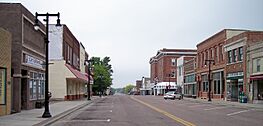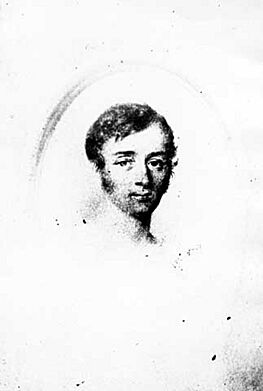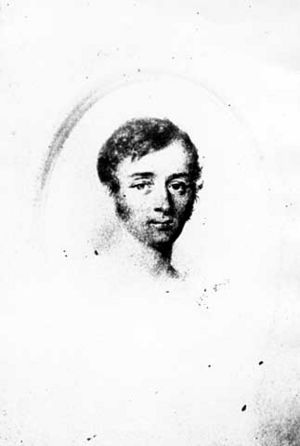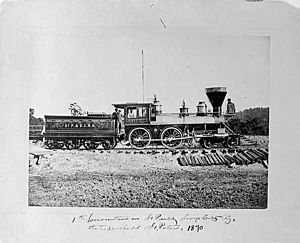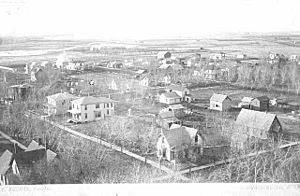Worthington, Minnesota facts for kids
Quick facts for kids
Worthington, Minnesota
|
|
|---|---|
|
Tenth Street in downtown Worthington in 2007
French explorer Joseph Nicollet
First train on the St Paul & Sioux City Railway
Worthington in 1893
|
|
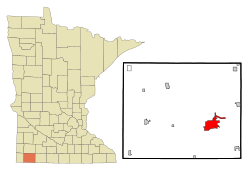
Location of Worthington in Nobles County, Minnesota
|
|
| Country | United States |
| State | Minnesota |
| County | Nobles |
| Founded | 1871 |
| Incorporated | April 29, 1872 |
| Government | |
| • Type | Mayor–Council |
| Area | |
| • City | 9.337 sq mi (24.183 km2) |
| • Land | 7.952 sq mi (20.596 km2) |
| • Water | 1.385 sq mi (3.588 km2) |
| Elevation | 1,572 ft (479 m) |
| Population
(2020)
|
|
| • City | 13,947 |
| • Estimate
(2023)
|
13,614 |
| • Density | 1,714.57/sq mi (661.99/km2) |
| • Urban | 13,800 |
| • Metro | 21,727 (US: 496th) |
| Time zone | UTC–6 (Central (CST)) |
| • Summer (DST) | UTC–5 (CDT) |
| ZIP Code |
56187
|
| Area code(s) | 507 and 924 |
| FIPS code | 27-71734 |
| GNIS feature ID | 2397378 |
| Sales tax | 7.875% |
Worthington is a city in Nobles County, Minnesota, United States. It is also the county seat, which means it's where the county government is located. In 2020, about 13,947 people lived there.
Contents
A Look Back in Time
The first European to likely visit the Nobles County area was a French explorer named Joseph Nicollet. He mapped the land between the Mississippi and Missouri Rivers in the 1830s. Nicollet called this area "Sisseton Country," named after the Sisseton band of Dakota Indians who lived there.
The land was a vast, flat prairie covered in grass. One small lake on Nicollet's map was named "Lake Okabena." In the Dakota language, "Okabena" means "nesting place of the herons."
How Worthington Started
Worthington was founded by people from New England and upstate New York. These settlers were descendants of the English Puritans who first came to New England in the 1600s.
In 1871, the St. Paul & Sioux City Railway Company began building a train line. Steam trains needed a lot of water, so water stations were built every eight to twelve miles. One of these stations was at the spot where Worthington is today. It was first called "The Okabena Railway Station."
That same year, Professor Ransom Humiston and Dr. A.P. Miller started a group called the National Colony. They wanted to create a village for settlers who believed in temperance, meaning they avoided alcohol. Many of these settlers were from religious groups like the Congregationalists, Methodists, and Presbyterians.
The town was planned, and its name was changed from Okabena Railway Station to Worthington. This new name came from Dr. Miller’s mother-in-law’s maiden name.
Early Days and Challenges
On April 29, 1872, the first passenger train arrived in Worthington, bringing the first National Colony settlers. One early settler described the new town: "There was a good hotel, well and comfortably furnished, one or two stores neatly furnished and already stocked with goods... The streets... were full of prairie schooners, containing families waiting until masters could suit themselves with 'claims,' the women pursuing their housewifely avocations meanwhile... all seeming happy and hopeful."
Not all settlers agreed with the temperance rules. Some were Civil War veterans who enjoyed drinking. A funny event happened on Worthington’s first Fourth of July celebration. Professor Humiston found a keg of beer at the Worthington House Hotel. He took it outside and smashed it with an axe.
In response, some young men of the town got a band and marched with the broken keg, playing a "dead march." They buried the empty keg with a mock soldier's funeral. Then, they got a full keg of beer and invited everyone to drink. That evening, they even burned a dummy of Professor Humiston!
Despite these disagreements, the town grew quickly. By the end of summer 1872, 85 buildings had been built where there was only prairie grass a year before.
Growth and New Arrivals
Many settlers came to the region, especially from New England and upstate New York. They were looking for new land because their home areas were becoming crowded. Worthington, like much of Minnesota, shared a lot of its culture with early New England.
This was the time of the Homestead Act, which allowed people to claim 160 acres (about 0.65 square kilometers) of government land for free. They just had to live on the land and "improve" it. Many settlers arrived who were not part of the temperance movement.
The first winter was very harsh. In the summer of 1873, swarms of grasshoppers ate all the farmers' crops. Still, more settlers came. 1874 brought a great harvest, but then more grasshoppers came in 1875. 1876 and 1877 were good farming years. The grasshoppers returned one last time in 1879, and then the area began to thrive. By 1880, Nobles County had 4,435 residents, with 636 living in Worthington.
In the early 1900s, many German immigrants arrived in Worthington. Most of them came from other parts of the Midwest, like Ohio, where their communities were already set up. Unlike in some other places, the German immigrants were welcomed by the original settlers. This led to more Germans moving to the area, as people wrote back to Ohio about how good it was.
Later, other immigrant groups like people from Ireland, Norway, and Sweden also settled in southwestern Minnesota. For these immigrants, it was a chance for a new life.
In 2006, a government agency called Immigration and Customs Enforcement (ICE) visited the Swift & Company meat packing plant in Worthington. They interviewed workers there.
Geography and Location
Worthington covers about 8.74 square miles (22.6 square kilometers). Most of this area, about 7.34 square miles (19.0 square kilometers), is land. The rest, about 1.40 square miles (3.6 square kilometers), is water.
Population and People
| Historical population | |||
|---|---|---|---|
| Census | Pop. | %± | |
| 1880 | 636 | — | |
| 1890 | 1,164 | 83.0% | |
| 1900 | 2,386 | 105.0% | |
| 1910 | 2,385 | 0.0% | |
| 1920 | 3,481 | 46.0% | |
| 1930 | 3,878 | 11.4% | |
| 1940 | 5,918 | 52.6% | |
| 1950 | 7,923 | 33.9% | |
| 1960 | 9,015 | 13.8% | |
| 1970 | 9,916 | 10.0% | |
| 1980 | 10,243 | 3.3% | |
| 1990 | 9,977 | −2.6% | |
| 2000 | 11,283 | 13.1% | |
| 2010 | 12,764 | 13.1% | |
| 2020 | 13,947 | 9.3% | |
| 2023 (est.) | 13,614 | 6.7% | |
| U.S. Decennial Census 2020 Census |
|||
The U.S. Census Bureau now calls Worthington a "micropolitan area." This means it's a smaller city that is the center of a larger area. Its population is around 20,508 people.
In recent years, many immigrants, especially from Hispanic backgrounds, have moved to Worthington. Some people believe this has helped the city's economy grow.
In 2022, there were about 4,570 homes in Worthington, with an average of almost 3 people per home. The average household income was $58,690. About 15.4% of the city's population lived at or below the poverty line. About 62.4% of the population was employed.
Many people in Worthington have different backgrounds. The top reported ancestries include English (54.5%), Spanish (32.7%), Asian and Pacific Islander (7.0%), and other groups. The average age in the city was 33.1 years old.
Population Changes (2020 Census)
| Race / Ethnicity | Pop 2000 | Pop 2010 | Pop 2020 | % 2000 | % 2010 | % 2020 |
|---|---|---|---|---|---|---|
| White alone (NH) | 7,934 | 6,238 | 4,864 | 70.32% | 48.87% | 34.88% |
| Black or African American alone (NH) | 205 | 682 | 946 | 1.82% | 5.34% | 6.78% |
| Native American or Alaska Native alone (NH) | 33 | 51 | 38 | 0.29% | 0.40% | 0.27% |
| Asian alone (NH) | 783 | 1,081 | 1,248 | 6.94% | 8.47% | 8.95% |
| Pacific Islander alone (NH) | 0 | 7 | 0 | 0.00% | 0.05% | 0.00% |
| Some Other Race alone (NH) | 9 | 21 | 28 | 0.08% | 0.17% | 0.20% |
| Mixed Race/Multi-Racial (NH) | 144 | 163 | 225 | 1.28% | 1.28% | 1.61% |
| Hispanic or Latino (any race) | 2,175 | 4,521 | 6,559 | 19.28% | 35.42% | 47.03% |
| Total | 11,283 | 12,764 | 13,947 | 100.00% | 100.00% | 100.00% |
Note: The U.S. Census counts Hispanic/Latino people as an ethnic group. This table separates them from the main racial groups.
Population Details (2010 Census)
In 2010, Worthington had 12,764 people living in 4,458 households. About 34.7% of households had children under 18. The average household had 2.79 people.
The average age in the city was 33.5 years. About 26.8% of residents were under 18, and 15% were 65 or older. The population was almost evenly split between males (51.1%) and females (48.9%).
Fun Events and Culture
Worthington hosts several exciting events each year:
- Windsurfing Regatta & Music Festival (June)
- International Festival (July)
- King Turkey Day (September)
- Holiday Parade (November)
Schools and Learning
Worthington is part of Independent School District 518. The school mascot is the Trojan. Their sports teams play in the Big South Conference.
The school district is known for its strong music programs, including band, orchestra, choir, and theater. The Worthington Senior High School's 'Spirit of Worthington' Trojan Marching Band has over 160 members and has performed nationally five times. They performed in the McDonald's Thanksgiving Day Parade in Chicago in 2008 and 2011. In 2019, they were a featured band at the Chick-fil-A Peach Bowl in Atlanta, Georgia.
- High School: Worthington Senior High School
- Middle School: Worthington Middle School
- Elementary School: Prairie Elementary School
Worthington also has private schools:
- Worthington Christian School (grades K-8)
- St. Mary's Elementary School (grades K-6)
For higher education, Worthington has Minnesota West Community and Technical College. This two-year college offers associate degrees, diplomas, and certificates in many subjects.
The Nobles County Library serves Worthington and the surrounding area. It is part of the Plum Creek Library System.
Getting Around Worthington
Transportation Options
- Prairieland Transit System (local public transport)
Major Roads
 Interstate 90
Interstate 90 U.S. Route 59
U.S. Route 59 Minnesota State Highway 60
Minnesota State Highway 60 Minnesota State Highway 266 (now Nobles County Road 25)
Minnesota State Highway 266 (now Nobles County Road 25) Nobles County Road 25
Nobles County Road 25 Nobles County Road 35
Nobles County Road 35
Local News
The Globe newspaper serves Worthington and Nobles County. It publishes a print edition on Wednesdays and an online edition on Saturdays.
Famous People from Worthington
Many notable people have connections to Worthington:
- Dwayne Andreas, a business leader, was born here.
- Wayne R. Bassett Sr., a librarian and state legislator.
- William Elijah Bloom, a state legislator.
- Wendell Butcher, a football player.
- George Dayton, a banker and real estate developer who started in Worthington.
- Matt Entenza, a former state legislator.
- Gordon Forbes, a lawyer and state legislator.
- Francis G. Judge, an electrician and state legislator.
- Big Tiny Little, a pianist and TV personality.
- Peter Ludlow, a philosopher.
- Stephen Miller, the fourth Governor of Minnesota.
- Gordon Moore (judge), an Associate Justice of the Minnesota Supreme Court.
- Lee Nystrom, an NFL player, was born here.
- Tim O'Brien, a famous novelist.
- John Olson, a state senator and Worthington native.
Sister City Connection
Worthington has a special "sister city" relationship with Crailsheim, Germany. This was the first such connection between an American and a German city! It began in 1947 when Martha (Cashel) McCarthy and her family helped collect clothes and food for the people of Crailsheim. Their city had been almost completely destroyed at the end of World War II.
See also
 In Spanish: Worthington (Minnesota) para niños
In Spanish: Worthington (Minnesota) para niños


